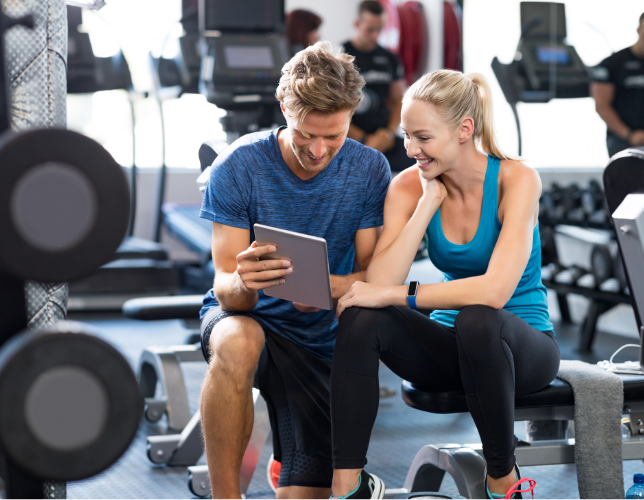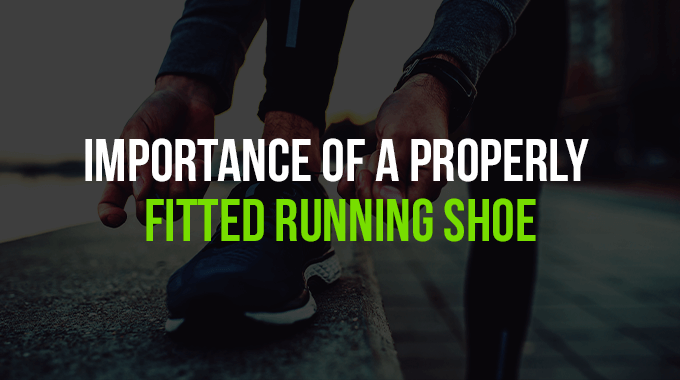
Subscribe to the Blog
Stay up to date

When it comes to buying running shoes, you want to find a shoe that will keep your feet and legs healthy for hundreds of miles. Although trendy colors and flashy designs can be tempting, it pays to choose the running shoes that save you from injury by fitting your feet well and supporting your stride.
This ultimate guide to running shoes will walk you through the makeup of a running shoe and how running shoes should fit. You'll also see how to find the right running shoe for your stride and running style. Discover everything you need to know about how to choose running shoes before purchasing a pair.

The Anatomy of a Running Shoe
Before diving into the details of how to pick the right running shoe, it's useful to know the basic structure of this footwear. Below, you'll discover the 12 fundamental components of a running shoe and how they can affect your stride.
1. The Upper
The upper refers to everything but the sole. Typically, the upper consists of layers of mesh and fabric glued or sewn together. You'll also find modern running shoe models using knitting or 3D printing to make one-piece uppers that flex to support the foot in all the right places.
When shopping for running shoes, try to find an upper that's shaped like your foot. Your shoes' upper should also be smooth wherever it contacts your foot so it doesn't bind or chafe.

2. The Saddle
You'll find the saddle of your shoe around the reinforced area near your instep — the upper part of your foot where it arches. The saddle works with the laces to secure the shoe to your foot. Over the years, running shoe creators have made a range of eyelets, overlays and lacing systems that mold this component closely to various foot shapes.
Be aware of how the saddle holds your foot when trying on running shoes. A well-fitted saddle won't permit any slippage while keeping your foot secure and offering room for your arch's natural curve as you run or walk.
3. The Toebox
The toebox spans from the edge of the eyelets to the front tip of your shoe, encompassing much of the upper. Often, the end of the toebox has a cap or reinforced bumper to protect your toes from stubbing. This bumper also protects the shoe material itself and is especially practical for trail shoes, which will be encountering much rougher terrain.
You want a toebox that isn't in the way, letting your foot move naturally in all directions. A toebox should never bind or rub your toes, which could indicate that the shoe is too narrow or small.
4. The Collar
The collar provides stability around your ankle. This padded wrap is at the top of the running shoe and helps hold your foot in place.
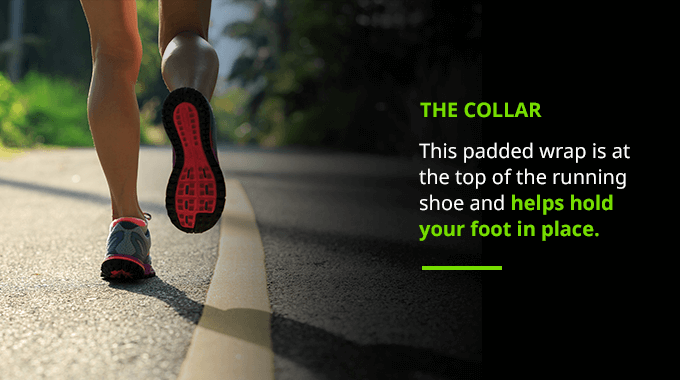
It may be stiffer or less rigid, giving you plenty of options to find your preferred style.
Whenever you try on running shoes, note how the ankle collar padding affects the bones on your ankle. Take notice of whether the way it curves irritates your Achilles tendon and whether your heel slips.
5. The Heel Cup
The heel cup or counter applies to the semi-rigid component inside the back of a shoe. Some running shoes have an outer wrap that cradles and supports the back of your foot. Minimalistic running shoes have no heel counter at all to grant the wearer improved freedom of movement.
The heel counter helps keep your foot centered when you land rather than offering motion control. Overall, you should look for a heel that promotes comfortable ankle movement.
6. The Toe Spring and Flex Grooves
Running shoe designers place flex grooves at the ball of the foot to make the shoe bend like a runner's foot does. A shoe with the toe turned up, known as toe spring, will also allow the foot to roll through each stride more easily. These minute differences can shift the mechanics and feel of a running shoe.
The amount of flex you need from your running shoe changes with speed, so you will need to figure out which level of flex works best with your stride. Look for a shoe that flexes or rolls with the way your foot moves naturally at your usual pace.
7. The Outsole
The outsole is the rubber part of the bottom of a running shoe that strikes the road with every stride. Typically, an outsole is made from a variety of rubber or foam compounds and placed in strategic areas. A well-placed outsole can enhance the flexibility and bounce of a shoe while increasing its wear life.
Your running shoe's outsole should give you a good grip without being too heavy or stiff. Look for an outsole footprint that's similar to yours for the best stability.
8. The Midsole
A shoe's midsole is the foam material between the upper and the outsole. The midsole cushions and guides your foot from impact forces as you land.
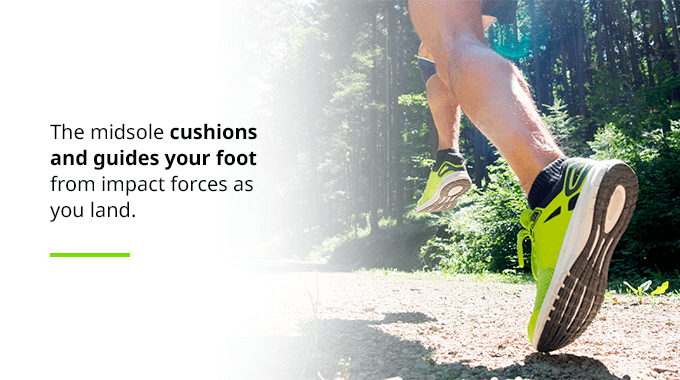
You will need to find the midsole thickness and material that feels best at your running speed — not too firm or too soft and without excess weight.
9. The Heel Cushioning
Heel cushioning is a part of the midsole that helps reduce the impact shock of a heel strike. Some shoes may boast of a softer "crash pad" section around the foot's outer edge or a rounded outer heel that helps smooths your landing. But your joints provide most of the cushioning for your body, and you may actually land harder in a heavily cushioned shoe, meaning heel cushioning is primarily a placebo.
Try to strike a balance among cushioning, ground feel and stability when trying out running shoes. Take note of whether the shoe lands where you expect it to and rolls into each stride in a natural way that feels right to you.
10. The Forefoot Cushioning
Forefoot cushioning is another type of midsole material made to lessen the strongest stride forces at the front of the foot. Although body mechanics naturally cushion everything above your ankle, high-quality forefoot cushioning can protect your foot's structure.
Along with foot protection, new and developing energy-return materials and designs claim to be able to propel your foot for increased speed. Be aware of a running shoe's responsiveness and look for one that simultaneously provides a firm push-off platform and cushioning comfort.
11. The Heel-Toe Drop
When you stand in a shoe, the heel-toe drop is the height difference between the ball of your foot and your heel. While experts have yet to reach a consensus about how the heel-toe drop relates to injuries, changing the heel-toe drop can alter your stride by distributing forces differently to your foot and leg.
Look for a running shoe that feels right throughout your stride, from toe-off to touchdown. Make sure the shoe also minimizes the stress placed on any weak parts of your foot.
12. The Sockliner
The sockliner is the removable pad of foam placed inside your running shoe. The sockliner is designed to cushion and soften the contours of the bottom of your foot.

Through working with the shoe's shape, the sockliner provides most of what's commonly known as arch support. This arch support is what gives a running shoe its initial step-in comfort.
You'll recognize a good sockliner by paying attention to how the shoe feels on the run. Keep in mind that your foot functions dynamically to provide much of its own support and cushioning, so a softer sockliner is not always better.
Bonus: Stabilizing Features
Some running shoe designs incorporate a variety of technologies, such as dual-density foams, guide rails and wider shoe geometries, to keep the foot from excess movement. Namely, these fancy features work to offset overpronation or rolling inward. While many people might not need pronation correction, this extra stability and control can help any runner maintain their preferred movement path.
What Is Pronation?
The term pronation applies to the way someone's foot rolls inward to distribute impact upon landing. As your foot hits the ground, it rolls inward to help your body absorb the shock. While pronation is a natural movement for the human body, it may look slightly different from person to person.
Because pronation forces your arch to support the rest of your foot and sustain an extraordinary amount of pressure, over or under pronating can make runners more prone to injury. Luckily, you can find the best running shoes for plantar fasciitis or running shoes to reduce knee pain and other types of overuse injuries. You just need to know your pronation type and search for shoes accordingly.
Check out the three types of pronation below to discover which stride you have.

Supination
For a supinator, the outer side of the heel strikes the ground at more of an angle, resulting in little to no inward rolling, also known as underpronation. This lack of pronation leads to a larger transmission of shock throughout the lower leg. This style of stride puts increased pressure on the outside of the foot and smaller toes.
Supinators typically have high arches and are more prone to developing plantar fasciitis, shin splints and ankle sprains due to the excess pressure on their arches. To prevent these injuries, supinators should look for running shoes with extra cushion to support their arch and absorb extra shock.
Neutral
A neutral stride refers to normal pronation with evenly dispersed weight and impact distribution. During a neutral stride, the foot lands on the outside of the heel and rolls inward to support body weight and absorb the shock of impact. Pushing off also involves even distribution from the front of the foot.
Those with a neutral stride typically have normal-size arches and are less likely to sustain an overuse injury because their feet naturally provide effective shock absorption. Neutral runners should remember they are not immune to injury and should replace their running shoes as soon as they show significant signs of wear and tear. Regular stability shoes typically provide adequate support for neutral runners.
Overpronation
When overpronators run, their feet land on the outside of their heels then roll inward excessively, transferring weight to the inner edge of the foot instead of the ball of the foot. Usually, overpronators have low arches or flat feet, which means the way they push off each stride forces the big toe and second-largest toe to do most of the work.
Putting excessive stress on the inside of their feet makes overpronators more likely to develop plantar fasciitis, heel spurs, shin splints and bunions. Overpronators can correct their excessive pronation with motion control shoes that provide extra stability and a wide sole to keep their feet from rolling too far inward.
Which Shoes Are Best for You?
Before you start shopping for running shoes, make sure you've got the right mindset. Make fit and feel your top priorities, not fashion. Keep in mind that the coolest-looking shoes might not be the most comfortable or practical for long-term training. When you choose a running shoe that matches your stride and fits well in all the right places, you are more likely to avoid preventable injuries.
In addition to prioritizing fit and feel, don't assume your size. Running shoe sizes can differ from brand to brand, so being one size in a certain brand doesn't mean you'll be the same in another. Pay more attention to the way each type of shoe is shaped, how it's stitched together, the way the upper curves and how it hugs your foot.
To avoid picking the wrong shoe size, get your feet measured each time you buy running shoes and always try a pair on before purchasing them. When you try on a pair of shoes, jog around in them for a bit to get a true feel of how they respond to the rhythm of your gait. You'll want a running shoe that feels supportive and firm yet comfortable and flexible.
Finally, you will need to consider your training style, goals and surfaces. Think about whether your shoes will be pounding the pavement or navigating complex trails more frequently. Details like these will determine whether you need a shoe with more protection, stability or durability. Essentially, there are five main types of shoes you can choose from to accommodate your running needs.
Check out these five categories of running shoes to decide where your foot falls:
1. Lightweight Shoes
Also known as racing flats, lightweight shoes are built for speed. You'll want a pair of lightweight shoes whenever you are racing an event or doing a speed workout, such as sprints or intervals. Lightweight shoes are so accommodative for speed because they feature far less foam and cushioning than most shoes, letting your feet move more naturally and dynamically without being weighed down.
Because lightweight shoes are designed with competition days in mind, they do not offer the amount of shock absorption or cushioning you will need for everyday training. For your regular runs, stick with running shoes categorized as neutral or stable.
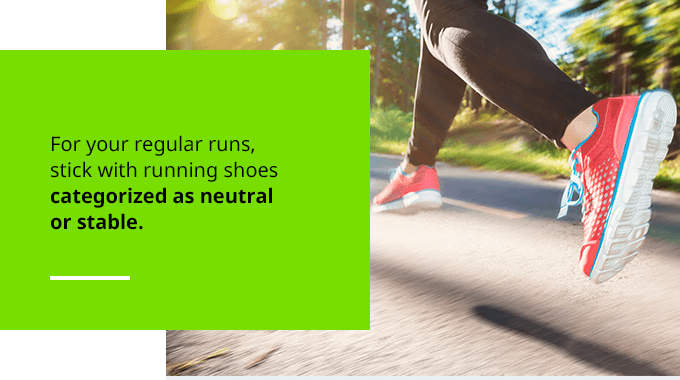
If you're still in the beginning phases of your training program, you won't need running shoes for races for a while.
2. Stability Shoes
Typically, stability shoes are recommended to runners who have neutral feet or a normal arch. These runners tend to perform best with shoes that combine midsole cushioning with good support. Stability shoes provide enough arch and ankle support throughout the gait cycle to help prevent excessive pronation without including too much support, making them great neutral pronation running shoes.
3. Cushioned Shoes
As their name implies, cushioned shoes are designed with extra cushioning for a more plush feel without many corrective or supportive elements.
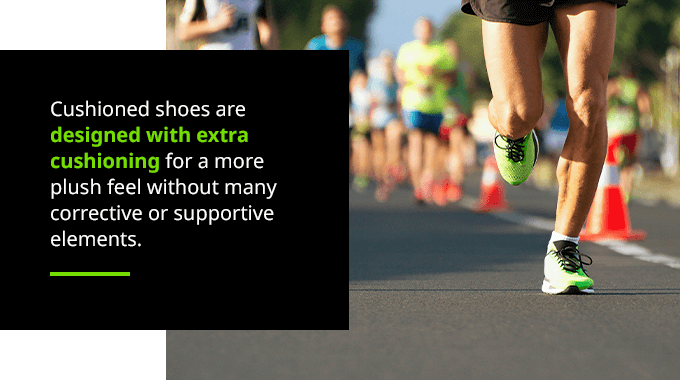
The majority of cushioned shoes are constructed with shock dispersion features in their midsole or outsole portion around the forefoot or heel regions. In this way, cushioned shoes help counteract supination.
Because cushioned shoes provide both protection and shock absorption with hardly any extra support, they are some of the best running shoes for underpronation and runners with high arches. The corrective and supportive elements of cushioned shoes counteract supination by lightly padding the outer portion of the foot.
4. Motion Control Shoes
As some of the best running shoes for overpronation, motion control shoes are often recommended for runners whose feet roll inward excessively. This type of shoe tends to fit those with low arches best because they are more likely to moderately or seriously overpronate. Motion-control shoes have a wide sole and are more rigid than most other running shoes, which limits pronation throughout the gait cycle.
Runners looking for a shoe that will provide high stability and durability may also like the fit of motion control shoes. The added foot support of motion control shoes makes them some of the best running shoes for shin splints. Overall, these stability shoes for overpronation are great running shoes for training runs or for anyone who needs some extra arch support.
5. Trail Shoes
Running shoes for trail runs are a hybrid of running sneakers and hiking shoes. Because the average trail runner needs to navigate rocks, mud, dirt, and other off-road obstacles, their shoes have to offer the best protection, stability, and support.
To meet these needs, shoe companies make trail shoes with extra ankle support and a superior grip for traction and control on soft, uneven or slippery surfaces. Trail shoes also guard runners' feet from the roots and rocks often found along rugged trails. These features make trail shoes ideal for running on all sorts of surfaces, from grass and mud to hard-packed dirt paths and roads.
Signs You Could Be Using the Wrong Running Shoes
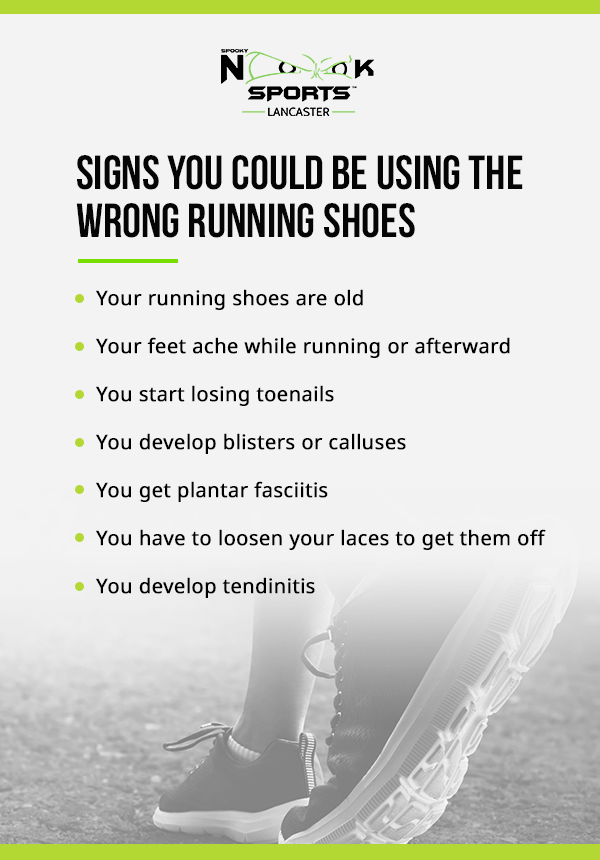
If you're uncertain whether it's time to start looking for new running shoes, look for these signs:
- Your running shoes are old: Your running shoes should never have a birthday. If you're approaching one year of running in the same shoes, it's time to get a new pair. Running on worn-down shoes can lead to injuries, such as joint or tendon issues.
- Your feet ache while running or afterward: As the foundation of your stride, your feet need to feel comfortable in your running shoes. If your shoes don't support your arch and heel in a way that allows your feet to strike the ground right, start looking for a shoe that positions your foot better.
- You start losing toenails: You don't want your toes to touch the end of your shoe when you run, even when going downhill. If your toes are constantly pressing against the end of your shoe, you may need to go a half size bigger for your next pair.
- You develop blisters or calluses: Blisters and calluses on your feet are the results of prolonged pressure and friction. These issues are a strong indication that your shoes are too narrow or too short or the supportive material inside of your shoe is breaking down. If you start developing blisters or calluses, it is always best to address the problem early.
- You get plantar fasciitis: Your plantar fascia is the long band of connective tissue underneath your skin that attaches your heel to your toes. If this band of tissue becomes inflamed, you can develop a condition known as plantar fasciitis. Plantar fasciitis feels like a stabbing pain in your heel when you first wake up or while running. Fortunately, plantar fasciitis can often be prevented by wearing shoes with the right amount of support.
- You have to loosen your laces to get them off: Exercising increases blood flow to your hands and feet, which can result in your feet swelling. If you have to completely loosen your laces to take your shoes off after each run, you may need a wider shoe size. Look for a wide running shoe that still allows your heel to sit comfortably in the shoe without slipping.
- You develop tendinitis: Tendinitis occurs whenever the thick, fibrous cords that connect a muscle to a bone become inflamed. Typically, the condition makes the tendon and affected area painful, tender and swollen. Most often, runners get tendinitis in their Achilles tendons, feet and ankles if they wear a running shoe that lets their ankle roll toward the inside.
If you're still unsure whether you need a new or a specific type of running shoe, visit a specialty running store. There, you can measure your size, assess your gait and test out the shoes before buying them. Make sure to try on a few pairs of shoes to get an accurate idea of what different styles and brands feel like.
Put Your Running Shoes to the Test at Spooky Nook Sports
Once you find the perfect pair of running shoes for your gait and training style, break them in at Spooky Nook Sports. At Spooky Nook Sports, we offer cutting-edge cardio equipment and indoor track surfaces for you to make the most of your running shoes.
Check out the wide variety of fitness and training options available at Spooky Nook Sports and start putting your running shoes to good use today!











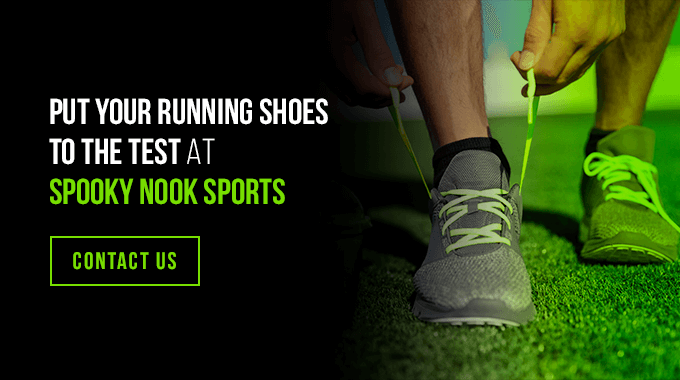
.png)
